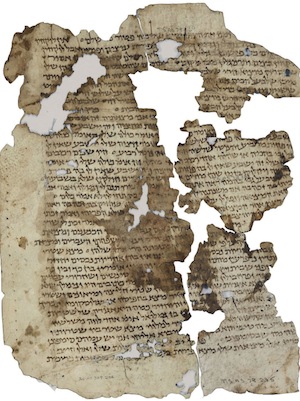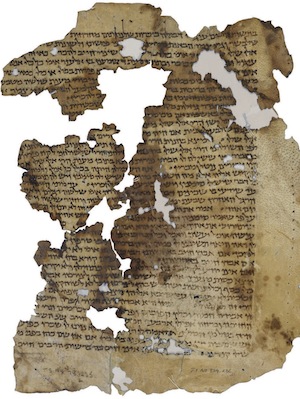A Genizah manuscript of the Mishnah
By Hayim Lapin, University of Maryland
During work on witnesses for Chapter 2 of Bava Meṣiʿa for The Digital Mishnah Project (initiated autumn of 2010), I noticed that four fragments from the Taylor-Schechter Collection were parts of a single sheet:
- T-S AS 78.162
- T-S AS 78.235
- T-S AS 78.69
- T-S NS 329.286
The identification of the join (shown after joining in Photoshop in Figures 1 and 2) was made before the publication of the new Thesaurus of Talmudic Manuscripts, which now confirms this finding. In fact, the Thesaurus identifies an additional eight fragments (in join group 155) that span the entire order of Neziqin.
The Digital Mishnah Project has the goal of creating a born-digital critical edition of the Mishnah. A demonstration application based on the sample chapter of Bava Meṣiʿa 2 shows some of the basic functionalities envisioned:
- Ability to view textual witnesses individually. Currently the demo presents the witnesses in the page layout of the original manuscript, but comments on the demo have suggested that users will want a more compact presentation as well.
- Alignment table (‘synopsis’, as it is referred to by Israeli scholars; ‘partitur’, by Assyriologists) of the text of all the witnesses or of select witnesses in a user-determined order.
- Text with apparatus criticus allowing a user to select a base text and witnesses to compare.
- Ability to present all or selected texts in a user-defined order in parallel columns (“synopsis,” in the usage of Peter Schäfer and his collaborators and students).
Additional data and functions will include:
- Textual citations from the talmuds and commentaries. (A file for a test case using the citations in printed edition of the Melekhet Shelomoh by Solomon Adani, d. ca 1625 has been prepared.)
- Navigation by page/column or by tractate/chapter/halakhah, when the amount of text requires this.
- Highlighting of personal and geographical names.
- Statistical measures of proximity and distance between witnesses.
- Search functions.
- Printable, exportable output.
Currently, the alignment is done on the fly using CollateX, a project of Interedition. In fact, two different versions of the demo are available using different versions of CollateX. In the middle term, the project may make several alignment techniques available to the user. In the long term, however, it may be that the project will encode the alignment into the edition itself.
The Sussman Thesaurus helps to concretize the scale of the project. My textual base began with one chapter and has expanded to all of tractate Neziqin (Bava Qamma, Bava Meṣiʿa, Bava Batra). There are nearly 230 separately listed items of Mishnah text in the catalog, not including most manuscripts of the Talmud Yerushalmi or Bavli.
The potential significance of the project for scholars of rabbinics is fairly straightforward: it will finally make good the lack of a critical edition of the Mishnah, and moreover do so dynamically. In addition, as a digital humanities project, the Digital Mishnah should also develop tools that are not specific to the project itself, and should utilize existing tools and contribute to the toolset available to scholars from many disciplines. The greatest potential, however, seems to me to be in the history of the medieval book. Unlike most digitization projects in rabbinics, the Digital Mishnah Project is not exclusively interested in extracting the text. We record considerable metadata on hand, date, format, and dimensions, and we tag significant manuscript and scribal detail so that a user with specific scholarly interests could, for instance, view and compare all manuscripts in an Ashkenazic hand, that use a particular abbreviation, and that are in a two-column format.
Of the almost 200 or so shelfmarks for the tractate Neziqin, the majority, about 160, come from the Genizah. Of these, 135 resolve into twenty joined manuscripts of different types in terms of format, content, and hand. The manuscript illustrated in Figures 1 and 2 has dimensions of 24.5 by 28.5 cm. One manuscript is in a small format (12 x 16 cm), in a semi-cursive hand (one fragment is T-S AS 81.74–75, join 157 in Sussman’s catalog). The fragments of this manuscript cover much of the order of Neziqin. Another has the text of the Mishnah in a large square hand, fully pointed and with cantillation marks, and a translation into Arabic in a smaller hand. This manuscript was produced on a 16 x 25 cm (one fragment is T-S AS 81.78; join 98) format. It includes tractates from ʿEruvin in Moʿed to Kelim in Ṭoharot, suggesting that the manuscript covered the entire Mishnah. Certainly, Maimonides’s autograph of the Commentary to the Mishnah covers the entire Mishnah, and appears to be among the largest in terms of format, about 29 x 35 cm, comparable to the size of the ‘Parma A’ manuscript of the Mishnah (Biblioteca Palatina 1137, de Rossi 138), or the ‘Kaufmann’ manuscript (Library of the Hungarian Academy of Sciences, A50). Many of the texts have annotations and corrections testifying to their use history. Who wrote or used these manuscripts? Can we distinguish personal copies from school texts from monumental display texts?
Beyond a foundational essay by Sussman (which now appears as part of the introduction to the catalogue), there is much work to be done on the circulation of the Mishnah as medieval book. The Digital Mishnah Project aims to be a tool in support of that work.
Recto of the reconstructed leaf
Verso of the reconstructed leaf
Bibliography
Sussman, E. Y. (ed.), Thesaurus of Talmudic Manuscripts (Hebrew; Jerusalem, 2012).
Cite this article
(2012). A Genizah manuscript of the Mishnah. [Genizah Research Unit, Fragment of the Month, November 2012]. https://doi.org/10.17863/CAM.62329
If you enjoyed this Fragment of the Month, you can find others here.
Contact us: genizah@lib.cam.ac.uk
The zoomable images are produced using Cloud Zoom, a jQueryimage zoom plugin:
Cloud Zoom, Copyright (c) 2010, R Cecco, www.professorcloud.com
Licensed under the MIT License


